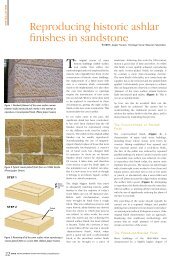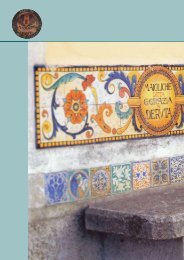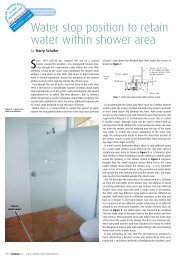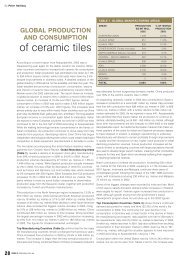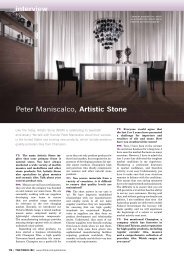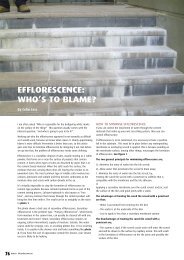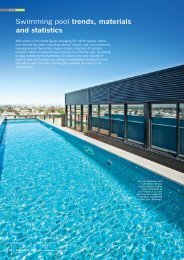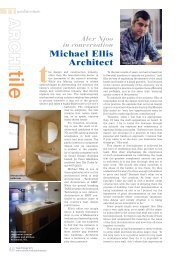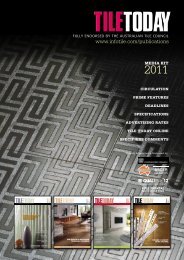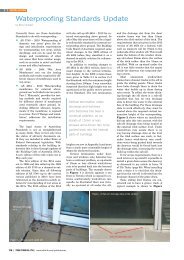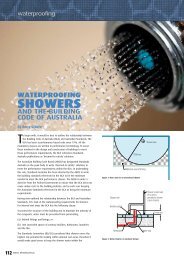Deterioration of Thin Marble Cladding - Infotile
Deterioration of Thin Marble Cladding - Infotile
Deterioration of Thin Marble Cladding - Infotile
Create successful ePaper yourself
Turn your PDF publications into a flip-book with our unique Google optimized e-Paper software.
installationFigure 1The new marble façade onFinlandia Town Hall –approximately 6 months after arecladding <strong>of</strong> the building.<strong>Deterioration</strong> <strong>of</strong><strong>Thin</strong> <strong>Marble</strong> <strong>Cladding</strong>a major international studyby Bent Grelk Ramboll, Copenhagen, Denmark, Björn Schouenborg SP Swedish National Testing and ResearchInstitute, Borås, Sweden, Katarina Malaga SP Swedish National Testing and Research Institute, Borås, SwedenThis intriguing article reveals that problems can and do occur, even with materials like Carrara marbles that have been used extensively for manyyears. The article also confirms that solutions can be found and improvements can be made. There is no sense in assuming that everything in thegarden is rosy, when it patently is not. These images could be enough to deter any specifier from choosing thin marble as a cladding material.However, despite the cost <strong>of</strong> repairs and the apparent severity <strong>of</strong> the highlighted problem, the majority <strong>of</strong> marble façade installations performadequately. This article serves to highlight the critical need for architects to be well informed about the materials they have at their disposal, andhow and where they can be used effectively. This report was partially funded by the European Commission and conducted by TEAM (Testing andAssessment <strong>of</strong> <strong>Marble</strong> and Limestone).BackgroundNatural stone has been used for facade applications since timeimmemorial. Originally, the stone employed was rather thick, whenused as a construction element, and the strength and durability wasvery consistent . Scientific research on properties <strong>of</strong> marble began inthe late 19th century. In the years following, the thickness <strong>of</strong> naturalstones used on facades decreased from over 1000 mm (as inconstruction elements) to 20-50 mm (in cladding applications) as aresult <strong>of</strong> new cutting technologies and equipment that was developedby industry.The use <strong>of</strong> thin marble and limestone slabs as facade cladding hasincreased substantially during the last few decades.Even though the vast majority <strong>of</strong> marble claddings performsatisfactorily, durability problems began to occur, following the advent<strong>of</strong> thin cladding materials. During recent years reports <strong>of</strong> facade failureshave increased dramatically.Prominent buildings such as the Amoco building in Chicago, theFinlandia City Hall in Helsinki, La Grande Arch and SCOR Tower in Parisand IBM Tower in Brussels have all experienced serious problems withtheir thin marble clad facades. The problems include expansion,bowing, loss <strong>of</strong> strength, and in the most serious cases completedetachment from the anchoring system.The bowing <strong>of</strong> marble is not only restricted to buildings. <strong>Marble</strong>tombstones have also been known to bow. At the present time, most<strong>of</strong> the recorded cases <strong>of</strong> façade failures emanate from Europe or NorthAmerica, because <strong>of</strong> the more widespread use <strong>of</strong> thin marble claddingsin those parts <strong>of</strong> the world. However, failures have also been recordedin Lebanon, Australia, India and Cuba.The problems regarding limestone facades are slightly different.Apparently, limestone does not bow, however it can expand causingserious problems if the joints are not sufficiently wide enough totolerate the expansion.The industry urgently needs to develop a repair system for existingfacades that develop problems. Despite several European researchprojects, the prime solution relies on replacing the panels at a cost <strong>of</strong>approximately 600-900 AUD $/m². The fairly recent example <strong>of</strong> theCity Hall in Helsinki, where all panels were replaced in 1998, came inat a cost <strong>of</strong> 6.5 Million AUD$ (a figure that was not dissimilar to theentire cost <strong>of</strong> the TEAM project). This provides an economicperspective <strong>of</strong> the problem. The problem did not cease because itwould appear that the new panels which were chosen incorrectlystarted to bow 6 months after installation! (Figure 1)It is estimated that the known cost <strong>of</strong> repairs to damaged facadeslocated in Europe will exceed AUD$400 million. This figure is based oncurrent strategies used to effect repairs. Although the vast majority <strong>of</strong>reported durability problems with thin marble or limestone slabs relateto use <strong>of</strong> Italian Carrara marble, which is the most widely used marblein the world, other marbles e.g. American, Norwegian and Portuguesehave also been reported to bow on facades. However, the reports onperformance <strong>of</strong> Carrara marble are inconsistent, since in some casesCarrara marble apparently performs satisfactorily. Note that there areabout 200 different stone quarries in operation in Carrara, Italy! Thedirection <strong>of</strong> the observed bow may be either convex or concave relativethe facade, this is probably determined by local climatic conditions.issue 9 www.discoveringstone.com.au22
Figure 2A close-up <strong>of</strong> the bowedCarrara marble panels onFinlandia Town Hall fewmonths before the panelswere replaced by new Carraramarble panels.Figure 3 The townhall in Malmo,Sweden features a27 year old Carraramarble facade thatis in perfectcondition.However, despite considerable effort the exact physico-chemicalprocesses responsible for the degradation <strong>of</strong> thin marble and limestoneslabs exposed to outdoor conditions have not been established by theresearch community. As a consequence <strong>of</strong> the reported durabilityproblems and the lack <strong>of</strong> fundamental understanding <strong>of</strong> the problem,both producers and users (architects and building owners) <strong>of</strong> marbleand limestone are almost desperate for more knowledge and inparticular they are eager to find a test method that will distinguishdurable building stones from nondurable building stones.ObjectivesThe main objectives in the TEAM were:• To understand and explain the mechanisms <strong>of</strong> the expansion andloss <strong>of</strong> strength, probably the most important phenomena leading todegradation <strong>of</strong> marble and limestone clad facades.• To prevent the use <strong>of</strong> deleterious marble and limestone byintroducing drafts for European standards.• The project also aimed to develop a concept for assessment <strong>of</strong>facades, including a monitoring system in order to predict strengthdevelopment and improve safety and reliability.• To analyse if surface coating and impregnation could prevent ordiminish the degradation.• The project has also addressed quality control aspects in order tooptimise the production conditions.Work carried outThe TEAM project consortium, representing 9 EU countries, comprised16 partners representing stone producers and trade associations,testing laboratories, standardisation and certification bodies,consultants, building owners and care-takers and producers <strong>of</strong> fixingand repair systems.A state-<strong>of</strong>-the-art report has been written and is based on an extensivecompilation <strong>of</strong> more than 300 papers on marble and limestonedeterioration dating from late 1800s to 2005. A survey <strong>of</strong> about 200buildings has given a clear picture <strong>of</strong> the extent <strong>of</strong> the problem ingeographical, geological and climatic terms.Detailed case studies <strong>of</strong> 6 buildings have resulted in a methodology forassessment <strong>of</strong> facadesincluding monitoring system and risk assessment.Research, both in the laboratory and the field was performed on alarge number <strong>of</strong> different natural stones from various countriesutilised in varying climates. This provided an explanation <strong>of</strong>degradation mechanisms and lead to the determination <strong>of</strong> the criticalinfluencing factors.Two tests methods, including precision statements: one for bowing andone for thermal and moisture irreversible expansion have beenprepared for submission to CEN TC 246.Repair techniques based on the use <strong>of</strong> surface coating andimpregnation systems has been tested in the laboratory and in field.Positive side effects including increased durability and easier cleaninghave been observed.Guidelines for production and product control have been proposed. Aninstruction for stone sampling and description has been developed.Observation and results from the projectInspection and investigation <strong>of</strong> buildingsDuring the project a total <strong>of</strong> 194 Building Projects have been identifiedand reported on, providing various levels <strong>of</strong> detail. This includes 26Buildings that have been selected for further investigation.• All <strong>of</strong> the 26 Buildings were considered as suitable for dismantling<strong>of</strong> the facade panels for laboratory testing purposes.• Six buildings were selected for detailed field studies, measurements<strong>of</strong> bowing and supplementary investigations.• Two buildings were selected for long term monitoring.Based on the investigations we have concluded that the phenomenon<strong>of</strong> bowing <strong>of</strong> thin marble is actually rather common. Deformation bybowing is experienced in buildings <strong>of</strong> various ages, in buildingsexposed to various weather conditions and for slabs <strong>of</strong> variouswww.discoveringstone.com.au issue 923
installationthickness and dimensions and with different anchoring methods.Figure 4 Figure 5Finally, and what is most interesting, bowing is registered for marble <strong>of</strong>seemingly different composition and structure.It is important to note that the problem <strong>of</strong> bowing is not restricted toone type <strong>of</strong> marble or one climatic zone. The buildings are situated inNorthern, Central and Southern Europe, and there are buildings withbowed slabs in all countries (Austria, Belgium, Denmark, Finland,France, Germany, Greece, Italy, Netherlands, Norway, Portugal, Spain,Sweden, Switzerland and United Kingdom). Many <strong>of</strong> the buildings withproblems have been visited and a preliminary investigation has beenconducted. During these investigations several different marble typesfrom Greece, Italy, Portugal, Spain, Norway and USA have beenidentified as having durability problems in terms <strong>of</strong> bowing.It is also equally important to draw attention to the fact that manymarble and limestone claddings and pavements tend to be durable androbust, provided that the correct quality has been specified.The report also considered the possible effects <strong>of</strong> climate.It isreasonable to discuss the effects <strong>of</strong> different locations <strong>of</strong> the stonefacade slabs on the building itself – height above the ground anddirections <strong>of</strong> the compass. As for these parameters, our studies are inaccordance with the literature:• most pronounced bowing on the upper parts <strong>of</strong> the buildings and• most pronounced bowing on the facades that face southeast andsouthwest. Pronounced bowing also occurs on facades that facesouth. The claddings facing to the north display less tendency to bow.This implies that the facades which are subjected to the most sunlightFigure 6Figure 7Figures 4-6 Examples from Croatia depict a building façade that exhibits severe bowing.Figure 7 Bowing measurement on a façade.MULTI-FUNCTIONALBULLNOSE MACHINE• Low cost, high efficiency, easy operating • Effective processing length: 3100mm• Easy to maintain• Effective processing height: 200mm• Ideal for processing all kinds <strong>of</strong> straight border, • Vertical and horizontal grindingplane line and curve border• Working head adjustment degree: 360• Automatic edge pr<strong>of</strong>ile shape & polishing • Total power: 3.74kwBullnose from 20mm to 120mm thick• Price: $27,000 (excluding GST)Square edge up to 120mm thick• Free delivery Australia wide• Dimention: 3800mm X 1500mm X 1500mmwww.discoveringstone.com issue #700JY Diamond Tool Pty LtdPO Box 63, Moorabbin, Victoria 31892/26-28 Christensen St, Cheltenham, Victoria 3192Tel: (03) 9532 0268 Fax: (03) 9532 0242Toll free: 1800 999 893
installationexhibit the highest percentage <strong>of</strong> bowing panels and the largestamplitudes.• The bowing seems to be related to some types <strong>of</strong> marble andmarble/limestone while other stone types (travertine, slate, granite,sandstone etc) do not demonstrate this problem.• Both concave and convex bowing can occur on the same facadewith the same marble.• There is a clear correlation between bowing behaviour anddeterioration leading to loss <strong>of</strong> strength.• It cannot be stated that non-bowing stone slabs are notdeteriorating and loosing strength (e.g. mortised facade slabs seemto be hindered from bowing but might still deteriorate)• There are quite a few different types <strong>of</strong> marble (with various origins)that may bow. <strong>Marble</strong> selected from same region or even samequarry can demonstrate bowing as well as non-bowing behaviour.• Problems other than bowing and deterioration have been registeredand noted.• <strong>Marble</strong> types with known or measured bowing problems andmarked strength loss should be avoided in thin building claddings.Based on the observations it is also possible to conclude that revisionsin e.g.:• Application system (fixing methods)• Thickness <strong>of</strong> stone slabs• Panel face dimensions• Placement on the building may not totally hinder or reduce thedeterioration in such marbles.Investigations <strong>of</strong> selected buildings show large strength loss in theorder <strong>of</strong> 80 % after 35 years for one calcitic marble and 40 % for onedolomitic marble. Laboratory studies clearly indicate that there is nocorrelation between the amount <strong>of</strong> bowing and the loss <strong>of</strong> strength.This is especially worrying since there is a potential risk <strong>of</strong> severestrength loss without any evident bowing <strong>of</strong> claddings.It is surprising that, despite several reports <strong>of</strong> severe loss <strong>of</strong> strength,field investigations in relation to this topic are rare.Main ConclusionsThe TEAM project has significantly increased our knowledge <strong>of</strong> marbleand limestone deterioration processes.We hope that the findings will contribute to an increase in the use <strong>of</strong>marble and limestone for cladding and thus help restore some <strong>of</strong> thetrust lost in these materials in particular countries and climaticconditions. The main conclusions are given below:• A deeper understanding <strong>of</strong> the properties influencing the durability<strong>of</strong> marble and limestone as an outdoor cladding material has beengained, not the least through compiling and reviewing most <strong>of</strong> theliterature (over 300 articles) in this field and making it available toanybody through the homepage (see www.sp.se/building/team).• A comprehensive building survey, <strong>of</strong> about 200 buildings, has givena very good picture <strong>of</strong> the extent <strong>of</strong> the problem both geographicallyand geologically. Bowing is a worldwide phenomenon not confined toone type <strong>of</strong> marble or one type <strong>of</strong> climate, e.g. frosty conditions arenot necessary for this phenomenon to occur. Subsequent detailedcase studies have provided the possibility <strong>of</strong> testing severaldeterioration hypotheses and yielded important information aboutthe variables to be used in the test methods which were developedlater in the project, and are especially relevant to variations intemperature.• Sampling and testing <strong>of</strong> panels from the buildings have providedfurther information about the deterioration process and the rate <strong>of</strong>
installationFigure 9Figure 8 Bowed marble panelson a building in Helsinki,Finland.Figure 9 Microphoto (1.0x 1.5mm) Carrara marble withgranoblastic microstructure,marble with potential bowingbehaviour.Figure 10 Microphoto (1.0x1.5 mm) Carrara marble withxenoblastic microstructure. Amarble that does not bow.Figure 10change, together with the inspection methodology, this has provideda sound basis for building a model to predict the remaining servicelife, including analysis <strong>of</strong> the associated risk.• Long-term monitoring underlined the importance <strong>of</strong> repeatedmeasurements in order to enable reliable conclusions to be made.One time measurements are <strong>of</strong> little use due to large diurnal andseasonal variations.• The sampling <strong>of</strong> test materials is very critical for any project.Detailed sampling and sample marking instructions have to be usedfor any sampling. Our findings have been reported to CEN TC 246Natural Stone.• Laboratory testing <strong>of</strong> almost 100 different types <strong>of</strong> marble hastaken us much further in our search for the mechanism and allowedus to refute many “old” hypotheses. The main extrinsic influencingfactor is elevated temperature in the presence <strong>of</strong> a moisture gradient.This creates the external stresses that different marbles will thenrespond to in different ways. The most crucial intrinsic parameter isthe complexity <strong>of</strong> the grain boundaries and the grain size distribution<strong>of</strong> mineral grains in the rock. This provides different bonding strengthbetween the mineral grains due to the complexity <strong>of</strong> thearrangement <strong>of</strong> the grain boundary and in combination with thecrystal structure. The irregular grain structure that all marbleconsidered suitable for outdoor cladding have in common is theproduct <strong>of</strong> the metamorphism that turned limestone into a marblecombined with a dynamic recrystallisation event. Weaker bonds willcause granular de-cohesion, ’sugaring’, <strong>of</strong> the marble and significantstrength losses.• The work in developing the test methods has proved that everymarble is unique and has a unique response to climatic stresses withits own degradation curve. The acceleration factor <strong>of</strong> the laboratorybow-test is therefore different for different marble types. The testmethods developed enable a relevant evaluation that determineswhether a marble is suitable for outdoor cladding or not. The bowtestcan be adapted and used for predicting the remaining service life<strong>of</strong> a specific marble on a particular building.• Field exposures have shown that it is possible to inhibit or decreasethe degradation <strong>of</strong> marble by coating the surface with a hydrophobictreatment. The effect is most pronounced on marble already exposedand it should not be used to support the selection <strong>of</strong> an unsuitablemarble for a new building project.• Guidelines for designers and producers/suppliers have been givento ensure a proper selection <strong>of</strong> suitable marble and limestone foroutdoor cladding and to insure production with a homogeneous andacceptable quality respectively.AcknowledgementThe authors would like to thank the European Commission for financialsupport <strong>of</strong> the European research project “Testing and Assessment <strong>of</strong><strong>Marble</strong> and Limestone” (Contract no. G5RD-CT-2000-00233). The cooperationwith the project partners is gratefully acknowledged.Bent Grelk Ramboll Group, DenmarkBent Grelk is an experienced senior engineer at RAMBOLL Group, aconsultancy firm that has more than 4,000 employees at 70 <strong>of</strong>fices.Bent Grelk is specialized within the fields <strong>of</strong> concrete technology,condition survey <strong>of</strong> concrete structures and facades clad with naturalstones. He is in charge <strong>of</strong> Ramboll’s main Concrete and MaterialLaboratory in Virum, Denmark. He is an expert witness appointed bythe Danish Court <strong>of</strong> Arbitration in cases concerning problems withnatural stone. Bent Grelk has extensive experience in concrete andnatural stone testing.(contact: bng@ramboll.dk see also: www.ramboll.dk )Björn Schouenborg SP Swedish National Testing and Research Institute, SwedenBjörn Schouenborg is RTD Manager <strong>of</strong> SPs department <strong>of</strong> BuildingMaterials. SP is a governmentally owned limited company withapproximately 600 employees covering a wide range <strong>of</strong> activities suchas testing, research and product and quality system certification. SP isalso the national metrology laboratory. Mr Schouenborg has a PhD inMineralogy & Petrology and has been in charge <strong>of</strong> all researchactivities concerning bedrock materials and related products at SP since1990. Mr Schouenborg is the co-ordinator <strong>of</strong> the EU project TEAM(Testing and Assessment <strong>of</strong> <strong>Marble</strong> and Limestone)(contact: bjorn.schouenborg@sp.se see also www.sp.se)Katarina Malaga SP Swedish National Testing and Research Institute, SwedenKatarina Malaga is senior scientist at SPs department <strong>of</strong> BuildingMaterials and is responsible for development, investigation and testingwithin the Technical Area Natural stones/Dimension stones. MrsMalaga has a PhD in Inorganic Chemistry and MSc in Geology and hasbeen involved in several national and international research activities(TEAM, OSNET, I-STONE among others).(contact: katarina.malaga@sp.se see also www.sp.se)issue 9 www.discoveringstone.com.au28



